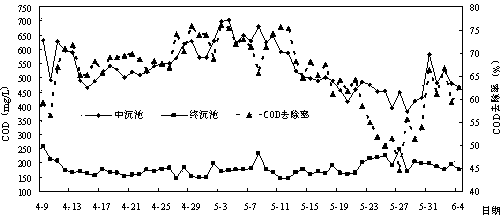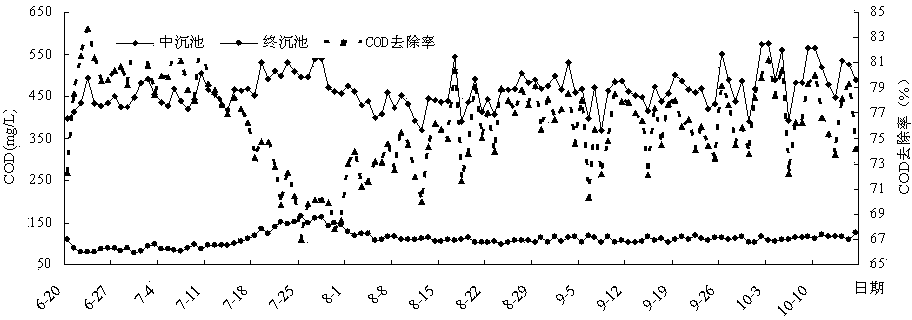Method for treating printing and dyeing wastewater by composite biological enzyme
A technology for compounding biological enzymes and printing and dyeing wastewater, applied in the textile industry wastewater treatment, water/sewage multi-stage treatment, water/sludge/sewage treatment, etc., to achieve high economic benefits, enhance anti-toxicity and impact resistance, reduce The effect of running costs
- Summary
- Abstract
- Description
- Claims
- Application Information
AI Technical Summary
Problems solved by technology
Method used
Image
Examples
Embodiment Construction
[0021] Please refer to the attached figure 1 Shown, the present invention is a kind of printing and dyeing wastewater treatment method utilizing compound biological enzyme, and it comprises following processing steps:
[0022] 1), pump the printing and dyeing wastewater into the regulating tank, and stay in the regulating tank for 10.5 hours;
[0023] 2), send the sewage into the primary sedimentation tank, and add FeSO 4 and liquid caustic soda, and stay in the primary sedimentation tank for 7.25 hours;
[0024] 3), send the sewage into the anaerobic tank, add anaerobic enzyme and coenzyme, and stay in the anaerobic tank for 14.9 hours; wherein, the anaerobic enzyme is a hydrolytic enzyme, and the coenzyme is a nutrient substance; the temperature of adding the enzyme is 20-40°C;
[0025] 4), send the sewage into the intermediate sedimentation tank, and stay in the intermediate sedimentation tank for 16.56 hours;
[0026] 5), send the sewage into the aeration tank, add aer...
PUM
 Login to View More
Login to View More Abstract
Description
Claims
Application Information
 Login to View More
Login to View More - R&D
- Intellectual Property
- Life Sciences
- Materials
- Tech Scout
- Unparalleled Data Quality
- Higher Quality Content
- 60% Fewer Hallucinations
Browse by: Latest US Patents, China's latest patents, Technical Efficacy Thesaurus, Application Domain, Technology Topic, Popular Technical Reports.
© 2025 PatSnap. All rights reserved.Legal|Privacy policy|Modern Slavery Act Transparency Statement|Sitemap|About US| Contact US: help@patsnap.com



